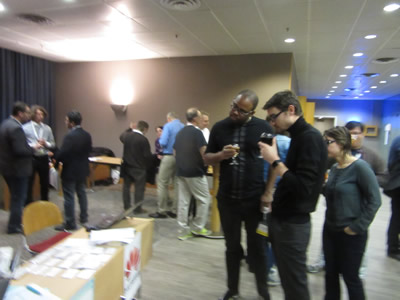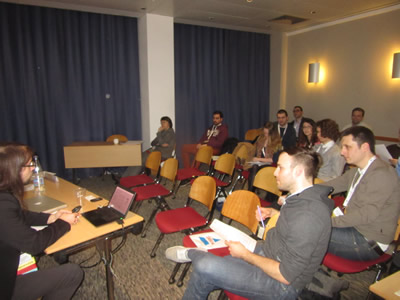eTELEMED 2019 - The Eleventh International Conference on eHealth, Telemedicine, and Social Medicine
February 24, 2019 - February 28, 2019
eTELEMED 2019
ISSN: 2308-4359
ISBN: 978-1-61208-688-0
eTELEMED 2019 is colocated with the following events as part of DigitalWorld 2019 Congress:
- ICDS 2019, The Thirteenth International Conference on Digital Society and eGovernments
- ACHI 2019, The Twelfth International Conference on Advances in Computer-Human Interactions
- GEOProcessing 2019, The Eleventh International Conference on Advanced Geographic Information Systems, Applications, and Services
- eTELEMED 2019, The Eleventh International Conference on eHealth, Telemedicine, and Social Medicine
- eLmL 2019, The Eleventh International Conference on Mobile, Hybrid, and On-line Learning
- eKNOW 2019, The Eleventh International Conference on Information, Process, and Knowledge Management
- ALLSENSORS 2019, The Fourth International Conference on Advances in Sensors, Actuators, Metering and Sensing
- SMART ACCESSIBILITY 2019, The Fourth International Conference on Universal Accessibility in the Internet of Things and Smart Environments
Special tracks:
ICH: Improving Communication in Healthcare
Chair and Coordinator:
Prof. Dr. Yoshitoshi Murata, Iwate Prefectural University, Japan y-murata@iwate-pu.ac.jp
IPCCH: Innovation Processes and Co-Creation in eHealth
Chair and Coordinator: Assoc. Prof. Dr. Niels F. Garmann-Johnsen, NORCE Research Institute and University of Agder, Norway niels.f.garmann-johnsen@uia.no
EPVC: Enabling Personalized Virtual Coaching
Chair and Coordinator: Talko B. Dijkhuis,
Institute of Communication, Media & IT, Hanzehogeschool of Applied Sciences,
The Netherlands t.b.dijkhuis@pl.hanze.nl
AICA: Artificial Intelligence in Clinical Applications
Chair and Coordinator: Dr. Oliver Heinze, University Hospital Heidelberg, Germany oliver.heinze@med.uni-heidelberg.de
eTELEMED 2019 conference tracks:
eHealth-as-a-Service (eHaaS)
Globalizing health informatics; eHealth Web science; ePatient Reputation in Health Fora; Challenges for eHealth; eHealth-enabled Health; Nursing eChart; eLiteracy in healthcare; ePoint.telemed; Home monitoring on chronic diseases; Big Data and Smart Health; eHealth and education via visual analytics; Experiences in national eHealth systems; eHealth and medication-related services; TeleCare trials; Resource and demands through eHealth service; eHealth in critical situations (heart failure, kidney blockage, mental health, etc.); eHealth services and chronic diseases; User satisfaction with eHealth services; Patient acceptance of eHealth systems; eHealth and pharmaceutical systems; eHealth and nurse practitioners; eHealth Apps (1st aid, locating a hospital, etc.); eHealth and ePrescribing systems; Online eHealth communities; Context-aware eHealth systems; eHealth portals; eHealth Literacies
Focus on self-managing patients
Patient-empowerment services; Patient access to personal health records; Self-training systems; Web-based self-management; Chronic disease self-management; Hybrid nurses and self-managing systems; Dedicated self-management systems (diabetes, hearth, cancer, etc.); Self-management systems for impaired patients; Challenges with remote and rural communities; Community-based participatory medical decisions; Inappropriate prescriptions in self-management systems; Health consumer-centric perspectives; Medication self-managing
Focus on patient records
Usability of health data to benefit patient and public health safety, privacy and security; Integrating heterogeneous clinical data into central data warehouses; Patient safety at transitions of care; Patient safety in critical care units; Health care processes in the intensive care units; Nursing quality indicator systems; Patient safety event reporting systems; Patient online access to their electronic health records; Patient safety risks associated with electronic health records; Patient generated clinical data and associated implications for electronic health records; Electronic dental records systems; Model-driven for standardized electronic health records; Semantic interoperable electronic patient records; Ontological knowledge base for managing patient safety events; Validating the access to an electronic health record; User-composable electronic health records; Privacy in hospital information systems; Interconnection of electronic medical record with clinical data management systems; Integrated management of medical records; Integration of electronic health records into nursing education; Automating health monitoring in compliance with personal privacy; Medication safety with clinical decision support systems; User-driven privacy expectations from hospital information systems; Sharing patient profile information among medical institutions; Big data in medical informatics; Ontologies of causal epidemiological knowledge; Visualizing patient data; Biomedical datasets; Global patient-data exchanges; Challenges for patient-records standardizing
eHealth technology and devices
Telemedicine software and devices; Diagnostic/monitoring systems and devices; Electronic health cards; Home monitoring services and equipment; Telemedicine equipments; Online instruments supporting independent living; eHealth telecommunication services; eHealth wireless data communications; IPTV and/or phone portal clients; Standardised biomarker analysis for intrinsic linkage to disease outcomes
eHealth data records
eHealth medical records; Reengineering of care plans in electronic format; Digital imagery and films; Internet imaging localization and archiving; Personal, adaptive, and content-based image retrieval imaging; Privacy and accuracy communications of patient records; Secure patient data storage; Secure communications of patient data; Authenticated access to patient records; Patient privacy-enhancing technologies (PETs); Robust approaches to algorithmic modeling of outcomes; Dynamic graphing of individual’s data trends; Data aggregation technologies; Delivery of information governance policies; Tools/systems for automatic document metadata tagging; Dataset harmonization across multiple sites; Standard/symbolic representations of multiple physiological trends and clinical/life events
eHealth information processing
Web technology in medicine and eHealth; Web-enabled consumer-driven eHealth; Electronic imagery and visualization frameworks; Color imaging and multidimensional projections; Imaging interfaces and navigation; Medical image processing; Video techniques for medical images; Computer vision and resolution; Rapid evaluation of patient's status; Anticipative processing of patient's status; Videoconferencing; Telepresence
eHealth systems and communications
Hospital information systems; Internet/intranet services; Surgical systems; Sensor-based systems; Satellite eHealth communications; Secure data transmissions; Body-sensor networks; Separation of concerns between domain problems and technological choices; Service-Oriented Architecture (SOA) approaches to maximize translation of clinical evidence; Cross-border eHealth systems; HealthGrid; Wireless 'flooding' technology providing cheap e-health platform support to whole towns/cities
eHealth systems and emergency situations
Medical emergencies and communications; Detection emergencies situations; Medical resource allocation, optimization, and simulation; Real-time emergency situations management; Security and accuracy of emergency communications; Geolocalisation and optimization technology services for emergency fleet vehicles
Telemedicine/eHealth applications
Virtual telemedicine; Mobile eHealth services; Home monitoring and homecare applications; Wireless homecare; User-generated eHealth care; Personalized medicine; Wireless telemedicine ; Telehomecare technologies for the elderly; Automatic detection of infectious diseases
Telemedicine/eHealth services
Clinical telemedicine; Distributed surgery; Telemedicine and telehealth; Telepathology; Telecardiology; Telerehabilitation; Elderly and impaired patient services; Remote operational medicine; Remote consulting services; Telemedicare monitoring; Vital signs monitoring; Computer generated self care advice; Telemedicine handbag; Workflow approaches to improve healthcare intervention outcomes; Workflow to improve patient safety, decision support, and objective measurement of service quality; Support for evidence-driven integrated care pathways (ICP’s)
Sociological, sociotechnical and multi-disciplinary perspectives on eTELEMED practices
Social relations, structures and processes, and co-production of humans and technology in telemedicine and e-health services; New service models and co-production of relations, structures and processes; Human agency and macro conditions for telemedicine and innovation; Policies and practices of electronic health and patient records; Micro and macro relations and collaboration between professionals in new integrated care models; Gender, age, ethics and power in assisted living services and technologies.
Social and financial aspects
Safety in telemedicine; Business models; Cost-benefit studies; Legal and ethical aspects; On-line payment and reimbursement issues; Ambient Assisted Living; Shared-care systems for eHealth; Privacy in the eHealth systems; Multi-lingual eHealth systems; Continuity in eHealth care; System simulations for business case development and risk reduction; Problem-independent (generic application) eHealth architecture; 'Lean' e-health workflows; ‘Relative risk' dashboards - how the patient's condition 'sits' within population risk
Classical medicine and eHealth integration
Wide-area integration of eHealth systems; Current eHealth realizations and projects; Innovation in eHealth; Telemedicine portals; Standardization and interconnectivity of eHealth systems; Implementation of cross-border eHealth services; eHealth integration into routine medical practice; Affordable approaches to e-Health; eHealth acceptance with medical professionals and patients; Developing countries and eHealth; Distance education for eHealth; xHR standardization; Impact of ‘global’ integration standards and interoperability projects (e.g. CDA, IHE/XDS, SNOMED-CT, Continua Healthcare Alliance, IEEE11073, Common User Interface (CUI)
Preventive eHealth systems
Systematic risk analysis technologies for disease early detection and prevention; 'Patient path' hubs, mobile devices and/or dedicated home-based network computers; Information models for evaluation of disease progression risk/disease processes; Systems supporting quantitative healthcare (predictive outcomes) modeling; Health risk factor data collation and multiple longitudinal trend analyses; Support for disease prevention aimed at healthy individuals; Data aggregation and visualisation technologies for population-based reporting; 'Risk signature’ discovery to indicate optimal preventative or screening actions; Mapping SNOMED-CT terminologies to disease model archetypes; Quantitative individualized outcome risk analysis; Services for longitudinal data analysis/visualisation; Continuous workflow management across clinic, home and mobile locations
Challenges of large-scale, cost-effective eHealth systems
Integrated technology, social/behavioral and business modelling research for large-scale deployments; Total operational cost-effectiveness modelling; Lessons from large-scale telehealth/telecare demonstrators in different parts of the world; Standardised data collation infrastructures (data service layers); Impact of grid and service-oriented computing; Roles of global/international interoperability organisations (e.g. IHE and Continua); Scaleable multi-data trend management; Robust data collection along the ‘patient path’ for improved decision support; Delivery of ‘composite’ process functions (e.g. contributed by multiple vendor systems); Paths to semantically-harmonised eHealth systems; Semantic interoperability and openEHR archetypes; Applications of harmonised (standardised) datasets across multiple sites; Keeping technology simple and affordable
Nurse team applications
ePatient and eNurse tools that are simple to adopt and use; Public eHealth education & information; Life time health records; Primary care centers and home monitoring; Monitoring for signs and progression of complications; eHealth awareness, education and adoption; Mapping to individualized care plans; Continuous ‘closed loop’ outcomes analysis; Intervention measurement technologies; Personal target setting
Personalized eHealth
eHealth Systems in Mental Health; Preventive Systems and mobile activity monitoring; eHealth and life; Fundamentals in eHealth personalization; Wearable and implantable systems; Micro and nano eHealth sensors; Diagnostics using biosensors and textiles; Interacting with organic semiconductors; Personalized eHealth market; Personalized eHealth business models; Ubiquitous monitoring; Personalized eHealth and classical health networks; Trends in personalized eHealth; ICT solutions for patient self-management
Clinical telemedicine
Stroke (Acute stroke; Thrombolytic therapy; Transient ischemic attacks; Telestroke); Eplilepsy (Acute management of seizures, Follow-up strategies, management of complications); ICU (remote intubation, Management of acute respiratory distress); Cardiaology (EKG interpretation, Tele-Echo, Management of acute coronary syndromes); Pediatrics (Epilepsy, Cardiology-echo interpretation, Pediatrics emergencies)
Rural and wilderness eHealth
Rural health and eHealth programs; Rural medical practice; Healthcare challenges in rural areas; Provincial standards of emergency care; Diagnosing in rural areas; Wilderness emergency medicine; Developing and nurturing online communities for health; Rural self-health care
Environmental and travel telemedicine
Disease control and prevention; Geo-medical surveillance; Travel health-related products, drugs and vaccines; Altitude medicine; Oceanic medicine; Continuous monitoring of travelers' health; Self-health care
Deadlines:
Submission | Nov 13, 2018 |
Notification | Dec 13, 2018 |
Registration | Dec 27, 2018 |
Camera ready | Jan 10, 2019 |
Deadlines differ for special tracks. Please consult the conference home page for special tracks Call for Papers (if any).
















